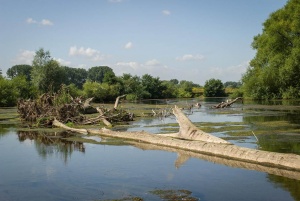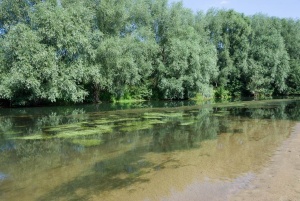Difference between revisions of "Lippeaue Klostermersch"
(→Hydromorphological response) |
(Undo revision 29001 by Benjamin Kupilas (talk)) |
||
| (20 intermediate revisions by 2 users not shown) | |||
| Line 11: | Line 11: | ||
==Site description== | ==Site description== | ||
The Lippe is a typical lowland sand and loam dominated river. Sine it has been altered since the Roman age and straightened as well as deepened it was difficult to assess the natural stable channel form of the river reach. | The Lippe is a typical lowland sand and loam dominated river. Sine it has been altered since the Roman age and straightened as well as deepened it was difficult to assess the natural stable channel form of the river reach. | ||
| + | |||
| + | [[File:Lippe_1.jpg|300px|thumb|left|Lippe river]] | ||
| + | |||
| + | [[File:Lippe_2.jpg|300px|thumb|left|Lippe river]] | ||
| + | |||
| + | |||
| + | |||
| + | |||
| + | |||
| + | |||
| + | |||
| + | |||
| + | |||
| + | |||
| + | |||
| + | |||
| + | |||
| + | |||
| + | |||
| + | |||
| + | |||
| + | |||
| + | |||
| + | |||
| + | |||
| + | |||
| + | |||
| + | |||
| + | |||
| + | |||
| + | |||
| + | |||
| + | |||
| + | |||
| + | |||
| + | |||
| + | |||
| + | |||
| + | |||
| + | |||
| + | |||
| + | |||
| + | |||
| + | |||
| + | |||
| + | |||
| + | |||
| + | |||
| + | |||
==Measures selection== | ==Measures selection== | ||
| Line 24: | Line 73: | ||
==Monitoring before and after implementation of the project== | ==Monitoring before and after implementation of the project== | ||
| + | The fish monitoring was desinged as a Before/After Impact/Control (BACI design). Hence, it was possible to investigate if the fish species composition and abundance did change after implementation of the project comapared to a control site (Impact/Control) and to investigate if these changes can be attributed to the restoration measures or if they also occur in the control reach (Before/After). | ||
==Socio-economic aspects== | ==Socio-economic aspects== | ||
| Line 30: | Line 80: | ||
==Extra background information== | ==Extra background information== | ||
| − | + | * [[Media:Beckers_2004_Lippe_Klostermersch.pdf | Beckers, B., Bunzel-Drüke, M., Hauswirth, L. , Geyer, H.J., Scharf, M. (2004): Monitoringuntersuchungen nach Maßnahmen zur Renaturierung bzw. Entfesselung der Lippe am Beispiel von Pflanzen (Disselmersch) und Fischen (Klostermersch). NUA Seminarberichte 9.]] <sub>(<i>language:</i> German)</sub> | |
| + | * [[Media:StuALippstadt_2002_Lippe_Klostermersch.pdf | Staatliches Umweltamt Lippstadt (2002): Die Klostermersch - Ein Fluss erobert seine Aue zurück.]] <sub>(<i>language:</i> German)</sub> | ||
==References== | ==References== | ||
Latest revision as of 14:34, 27 May 2014
Lippeaue Klostermersch
Key features of the case study
The restoration project in the floodplain of the Lippe river called "Klostermersch" is part of a restoration programme of the German federal state Northrhine-Westphalia that started in 1990 called "Gewässeraueprogramm" (river floodplain programme). So one of the major objectives of this programme was to restore river reaches including the surrounding floodplain, an aspect which is often neglected, even in the Programmes of Measures of the WFD.
Site description
The Lippe is a typical lowland sand and loam dominated river. Sine it has been altered since the Roman age and straightened as well as deepened it was difficult to assess the natural stable channel form of the river reach.
Measures selection
A 2 km reach was restored in 1996-1997. The bank fixation (riprap) was removed, the former channel was filled, channel bed was heightened by 2 m to connect the Lippe and its former floodplain and widened from 13 to 45 m. Several large trees were placed in the reach to initiate natural channel dynamics and to increase local depth variability. Floodplain land-use was restricted to extensive grazing to allow for natural succession of floodplain vegetation and the agricultural drainage system was filled, except some local ponds. A ramp was build at the downstream end to prevent channel incision.
Success criteria
Ecological response
A biological monitoring showed that species composition did still adjust to the changing morphological conditions several years after implementation of the project, i.e. is highly dynamic. Fish were monitored using a Before / After Impact / Control design (BACI). Most fish naturally occurring in the Lippe were already present prior to the restoration but abundance of many species did increase in the restored reach. Solely the abundance of eels was lower in the restored reach compared to the control reach since eels used riprap as cover. On the floodplain, amphibians recovered more slowly compared to fish, probably due to the lower re-colonization potential.
Hydromorphological response
Within a four year monitoring period, channel morphology consistently changed, depth variability increased and channel morphology was still adjusting to the post-project conditions; sediment balance was positive. The monitoring results indicate that the channel was slightly over-widened and in future projects, narrower channels will be build to allow for more natural channel dynamics (let the river do the work).
Monitoring before and after implementation of the project
The fish monitoring was desinged as a Before/After Impact/Control (BACI design). Hence, it was possible to investigate if the fish species composition and abundance did change after implementation of the project comapared to a control site (Impact/Control) and to investigate if these changes can be attributed to the restoration measures or if they also occur in the control reach (Before/After).
Socio-economic aspects
Contact person within the organization
Extra background information
- Beckers, B., Bunzel-Drüke, M., Hauswirth, L. , Geyer, H.J., Scharf, M. (2004): Monitoringuntersuchungen nach Maßnahmen zur Renaturierung bzw. Entfesselung der Lippe am Beispiel von Pflanzen (Disselmersch) und Fischen (Klostermersch). NUA Seminarberichte 9. (language: German)
- Staatliches Umweltamt Lippstadt (2002): Die Klostermersch - Ein Fluss erobert seine Aue zurück. (language: German)
References
Related Measures
- Increase flood frequency and duration in riparian zones or floodplains
- Widen water courses
- Shallow water courses
- Initiate natural channel dynamics to promote natural regeneration
- Introduce large wood
- Remove bank fixation
- Develop riparian forest
- Adjust land use to develop riparian vegetation
- Revegetate riparian zones
- Remove bank fixation
- Adjust land use to reduce nutrient, sediment input or shore erosion
- Improve backwaters
- Lower river banks or floodplains to enlarge inundation and flooding
- Reconnect backwaters and wetlands

